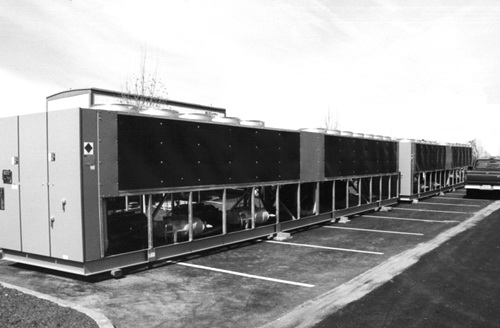| In general, equipment produces heat which warms up the room beyond acceptable operating temperatures , so the work of the support systems is to move cool air in to cool the machines, and to move hot air out. Sometimes the hot air is recycled, cooled, and returned to cool the machines. Cooling systems for conditioning the air take different forms, but typically the designs use water or refrigerants. The following figure shows two cooling towers awaiting installation. Figure 8-5. Cooling Towers Waiting to be Connected to an HVAC System  When designing the data center, the support system must be taken into consideration. Design concerns include: -
Adequate space. There must be adequate space to house large equipment such as chillers, cooling towers, condensers, and the requisite piping system. -
Climate. The climate of the area might partially determine the types of systems used. For example, using cooling towers that rely on simple heat transfer to the outside air will be less efficient in Las Vegas than, say, Toronto, since the normal ambient air temperature is higher. Local codes might have restrictions on what types of systems you must use. -
Flexibility. If there are plans to expand the data center in the future, expansion of the support system should also be considered . -
Redundancy. There must be enough built-in redundancy so that the loss of any one component of the system will not significantly impact the system as a whole. The system should be designed to allow for repairs or upgrades while the center is online. -
Minimize leaks. The system should be designed to minimize leakage of water or refrigerants within the controlled area of the data center. Piping should not be run through the ceiling void. Air conditioner piping (the lines that carry the coolant) should not run directly in front of the HVAC unit's exhaust that sends the chilled air out into the supply plenum. Multiple taps should be installed into chilled water piping to simplify configuration changes. The best data center layout would keep all piping out of the data center. This would involve placing HVAC units outside the controlled area with a catch system in place to drain any liquids away from the center. -
Monitor the system. The mechanical support systems must be connected to the building monitoring system. Status and critical alarms must be recorded and reported to Maintenance and IT. |
